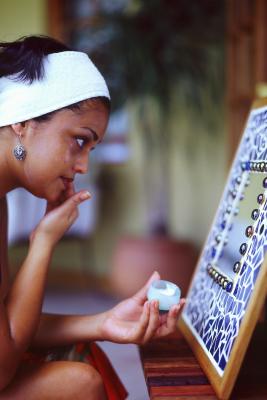You may become wiser with age, but aging does nothing good for your skin. As you age, you may notice wrinkling on your face, drier skin and dark pigmentation where you never had it before. Your skin may have lost its glow and may even look dull. When you get in your 50s and beyond, the skin on your neck gets looser, growths may appear, and you become more susceptible to bruising, itchy skin and a rash condition called shingles. While you can’t stop the aging process, you can prevent or lessen many of these skin problems.
Aging Face
When you age, your skin starts to lose collagen. Think of your face as a mattress and your skin the sheet. When you first purchase a mattress, it is full; when you cover it with a sheet, the sheet is taut. Over time, the mattress becomes lumpy, making the sheet on top loose. When your face loses collagen, your skin looks loose, lax and less smooth. Not only that, gravity is pulling everything down, causing your skin to sag.
The Sun
Besides the natural aging process and the genes you inherited, the worst offender to your skin is the sun. You can use the most expensive wrinkle creams in the world, but if you are exposing your skin to the sun without wearing sunscreen, you are wasting your effort when undertaking any sort of wrinkle treatment. Cigarette smoking also takes a toll on your skin.
Wear Sunscreen
The best way to fight wrinkles and other skin damage is to wear a sunscreen with an SPF of 30. If you are going to the beach or plan to spend the day outside exercising or gardening, wear a hat with a brim. The sun is strongest from 10 a.m. to 3 p.m., so for optimal sun protection, stay out of the sun during those hours.
Retinoic Acid and Fillers
The best treatment for wrinkles is retinoic acid, also called tretinoin. Tretinoin improves the surface of your skin. It reduces the pigmentation problems and increases collagen. Apply it every night; after several months, you may see good results. For deep creases, a dermatologist can use injectable filler, which goes under the wrinkles to puff them up. Botox is another option, which your dermatologist also injects, to reduce fine lines and wrinkles. While these treatments won’t bring back the skin of your youth, they can improve your skin’s appearance.
Moisturize
Because your skin dries out as you age, use a moisturizer immediately after your shower or bath, while your skin is still damp. Choose one that includes petrolatum or lanolin. The winter months can be particularly drying for your skin. If an over-the-counter moisturizer isn’t strong enough, talk to your doctor or dermatologist about getting a more effective moisturizer. Prevent some of your itchiness by using laundry detergent without perfumes because that can irritate skin.
Growths and Spots
Some skin growths and spots are just a part of aging; while some are harmless, some indicate skin cancer. Have your doctor check any red or brown scaly spots, a mole that changes in size, color or bleeds or a sore that doesn’t heal. It’s always best to remove these or undergo treatment early on before they become skin cancer.





